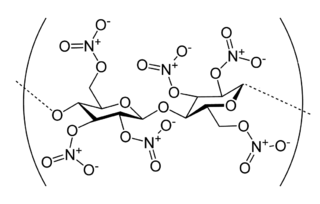Related Research Articles

Cue sports are a wide variety of games of skill played with a cue, which is used to strike billiard balls and thereby cause them to move around a cloth-covered table bounded by elastic bumpers known as cushions.

Bakelite, formally Polyoxybenzylmethyleneglycolanhydride, is a thermosetting phenol formaldehyde resin, formed from a condensation reaction of phenol with formaldehyde. The first plastic made from synthetic components, it was developed by the Belgian chemist and inventor Leo Baekeland in Yonkers, New York in 1907, and patented on December 7, 1909.

Cellulose is an organic compound with the formula (C
6H
10O
5)
n, a polysaccharide consisting of a linear chain of several hundred to many thousands of β(1→4) linked D-glucose units. Cellulose is an important structural component of the primary cell wall of green plants, many forms of algae and the oomycetes. Some species of bacteria secrete it to form biofilms. Cellulose is the most abundant organic polymer on Earth. The cellulose content of cotton fiber is 90%, that of wood is 40–50%, and that of dried hemp is approximately 57%.

Cordite is a family of smokeless propellants developed and produced in Britain since 1889 to replace black powder as a military firearm propellant. Like modern gunpowder, cordite is classified as a low explosive because of its slow burning rates and consequently low brisance. These produce a subsonic deflagration wave rather than the supersonic detonation wave produced by brisants, or high explosives. The hot gases produced by burning gunpowder or cordite generate sufficient pressure to propel a bullet or shell to its target, but not so quickly as to routinely destroy the barrel of the gun.

Nitrocellulose is a highly flammable compound formed by nitrating cellulose through exposure to a mixture of nitric acid and sulfuric acid. One of its first major uses was as guncotton, a replacement for gunpowder as propellant in firearms. It was also used to replace gunpowder as a low-order explosive in mining and other applications. In the form of collodion it was also a critical component in an early photographic emulsion, the use of which revolutionized photography in the 1860s.

The chemical industry comprises the companies that develop and produce industrial, specialty and other chemicals. Central to the modern world economy, it converts raw materials into industrial and consumer products. The plastics industry contains some overlap, as some chemical companies produce plastics as well as chemicals.

Petrochemicals are the chemical products obtained from petroleum by refining. Some chemical compounds made from petroleum are also obtained from other fossil fuels, such as coal or natural gas, or renewable sources such as maize, palm fruit or sugar cane.
Celluloids are a class of materials produced by mixing nitrocellulose and camphor, often with added dyes and other agents. Once much more common for its use as photographic film before the advent of safer methods, celluloid's common contemporary uses are for manufacturing table tennis balls, musical instruments, combs, office equipment, fountain pen bodies, and guitar picks.

Camphor is a waxy, colorless solid with a strong aroma. It is classified as a terpenoid and a cyclic ketone. It is found in the wood of the camphor laurel, a large evergreen tree found in East Asia; and in the kapur tree, a tall timber tree from South East Asia. It also occurs in some other related trees in the laurel family, notably Ocotea usambarensis. Rosemary leaves contain 0.05 to 0.5% camphor, while camphorweed (Heterotheca) contains some 5%. A major source of camphor in Asia is camphor basil. Camphor can also be synthetically produced from oil of turpentine.

A guitar pick is a plectrum used for guitars. Picks are generally made of one uniform material—such as some kind of plastic, rubber, felt, tortoiseshell, wood, metal, glass, tagua, or stone. They are often shaped in an acute isosceles triangle with the two equal corners rounded and the third corner less rounded. They are used to strum chords or to sound individual notes on a guitar.

Phenol formaldehyde resins (PF) are synthetic polymers obtained by the reaction of phenol or substituted phenol with formaldehyde. Used as the basis for Bakelite, PFs were the first commercial synthetic resins (plastics). They have been widely used for the production of molded products including billiard balls, laboratory countertops, and as coatings and adhesives. They were at one time the primary material used for the production of circuit boards but have been largely replaced with epoxy resins and fiberglass cloth, as with fire-resistant FR-4 circuit board materials.

A billiard ball is a small, hard ball used in cue sports, such as carom billiards, pool, and snooker. The number, type, diameter, color, and pattern of the balls differ depending upon the specific game being played. Various particular ball properties such as hardness, friction coefficient, and resilience are important to accuracy.

Carom billiards, also called French billiards and sometimes carambole billiards, is the overarching title of a family of cue sports generally played on cloth-covered, pocketless billiard tables. In its simplest form, the object of the game is to score points or "counts" by caroming one's own cue ball off both the opponent's cue ball and the object ball on a single shot. The invention as well as the exact date of origin of carom billiards is somewhat obscure but is thought to be traceable to 18th-century France.

Smokeless powder is a type of propellant used in firearms and artillery that produces less smoke and less fouling when fired compared to gunpowder. The combustion products are mainly gaseous, compared to around 55% solid products for black powder. In addition, smokeless powder does not leave the thick, heavy fouling of hygroscopic material associated with black powder that causes rusting of the barrel.
Ballistite is a smokeless propellant made from two high explosives, nitrocellulose and nitroglycerine. It was developed and patented by Alfred Nobel in the late 19th century.
Alexander Parkes was a metallurgist and inventor from Birmingham, England. He created Parkesine, the first man-made plastic.

John Wesley Hyatt was an American inventor. He is mainly known for simplifying the production of celluloid.
Daniel Spill was born in Winterbourne, Gloucestershire, England. He became a rubber and an early thermoplastics manufacturer. For over 20 years Spill had pursued the goal of making a successful business from Alexander Parkes' invention Parkesine, the first man-made plastic.
Polymer engineering is generally an engineering field that designs, analyses, and modifies polymer materials. Polymer engineering covers aspects of the petrochemical industry, polymerization, structure and characterization of polymers, properties of polymers, compounding and processing of polymers and description of major polymers, structure property relations and applications.
Crystalate is an early plastic, a formulation of nitrocellulose, camphor, and alcohol invented in the late 19th century and patented by American inventor George Henry Burt. It is best known as a material for gramophone records produced in the UK by Crystalate Manufacturing Company, and for moulded billiards, pool and snooker balls, as produced by the Endolithic Company.
References
- ↑ Painter, Paul C.; Coleman, Michael M. (2008). "The Early History of Polymers". Essentials of Polymer Science and Engineering. Lancaster, PA, US: DEStech Publications. pp. 7–9. ISBN 978-1932078756.
- 1 2 3 4 5 6 7 8 9 Bassett, Fred, ed. (2009). "Albany Billiard Ball Company Records, 1894-1944; Bulk 1915-1944". NYSL.NYSED.gov. Albany, NY, US: New York State Library, NYS Education Dept. "Manuscripts and Special Collections" section. Retrieved January 5, 2013.
- ↑ Harding, Robert S., ed. (March 1982). "Albany Billiard Ball Company Records 1869–1973 #11". American History Archives Center. Washington, DC: Smithsonian Institution. "Collections and Research Aids: Technology, Invention and Innovation Collections" section. Archived from the original on January 2, 2013. Retrieved January 5, 2013.
- ↑ US patent #105,338 issued July 12, 1870
- ↑ The Official Rules: '7 Ball', America's Fastest Growing, Most Popular New Game of Pool (PDF). Bridgeport, CT, US: S. B. Games/Big Fights Inc. 1981. Archived from the original (PDF) on January 5, 2013. Retrieved January 5, 2013.
Official "7 Ball—Made of 100% Cast Phenolic: Manufactured exclusively for playing "7 Ball" by Albany Hyatt Billiard Ball Company"
Four-page advertising pamphlet. - ↑ Lallanilla, Marc; Schlecht, Neil Edward; Silverman, Brian (2012). "Albany". Frommer's New York State. Frommer's Complete Guides. Hoboken, NJ, US: John Wiley & Sons. p. 282. ISBN 978-1118096017 . Retrieved January 5, 2013.